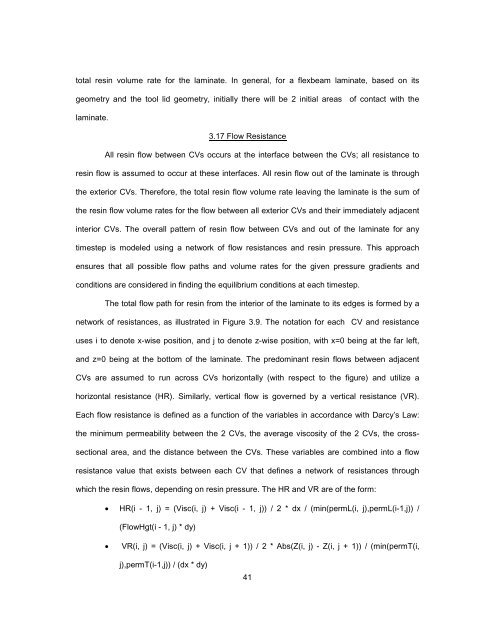TOOLED THICK COMPOSITES by ARVEN H. SAUNDERS III ...
TOOLED THICK COMPOSITES by ARVEN H. SAUNDERS III ...
TOOLED THICK COMPOSITES by ARVEN H. SAUNDERS III ...
You also want an ePaper? Increase the reach of your titles
YUMPU automatically turns print PDFs into web optimized ePapers that Google loves.
total resin volume rate for the laminate. In general, for a flexbeam laminate, based on its<br />
geometry and the tool lid geometry, initially there will be 2 initial areas of contact with the<br />
laminate.<br />
3.17 Flow Resistance<br />
All resin flow between CVs occurs at the interface between the CVs; all resistance to<br />
resin flow is assumed to occur at these interfaces. All resin flow out of the laminate is through<br />
the exterior CVs. Therefore, the total resin flow volume rate leaving the laminate is the sum of<br />
the resin flow volume rates for the flow between all exterior CVs and their immediately adjacent<br />
interior CVs. The overall pattern of resin flow between CVs and out of the laminate for any<br />
timestep is modeled using a network of flow resistances and resin pressure. This approach<br />
ensures that all possible flow paths and volume rates for the given pressure gradients and<br />
conditions are considered in finding the equilibrium conditions at each timestep.<br />
The total flow path for resin from the interior of the laminate to its edges is formed <strong>by</strong> a<br />
network of resistances, as illustrated in Figure 3.9. The notation for each CV and resistance<br />
uses i to denote x-wise position, and j to denote z-wise position, with x=0 being at the far left,<br />
and z=0 being at the bottom of the laminate. The predominant resin flows between adjacent<br />
CVs are assumed to run across CVs horizontally (with respect to the figure) and utilize a<br />
horizontal resistance (HR). Similarly, vertical flow is governed <strong>by</strong> a vertical resistance (VR).<br />
Each flow resistance is defined as a function of the variables in accordance with Darcy’s Law:<br />
the minimum permeability between the 2 CVs, the average viscosity of the 2 CVs, the cross-<br />
sectional area, and the distance between the CVs. These variables are combined into a flow<br />
resistance value that exists between each CV that defines a network of resistances through<br />
which the resin flows, depending on resin pressure. The HR and VR are of the form:<br />
• HR(i - 1, j) = (Visc(i, j) + Visc(i - 1, j)) / 2 * dx / (min(permL(i, j),permL(i-1,j)) /<br />
(FlowHgt(i - 1, j) * dy)<br />
• VR(i, j) = (Visc(i, j) + Visc(i, j + 1)) / 2 * Abs(Z(i, j) - Z(i, j + 1)) / (min(permT(i,<br />
j),permT(i-1,j)) / (dx * dy)<br />
41
















